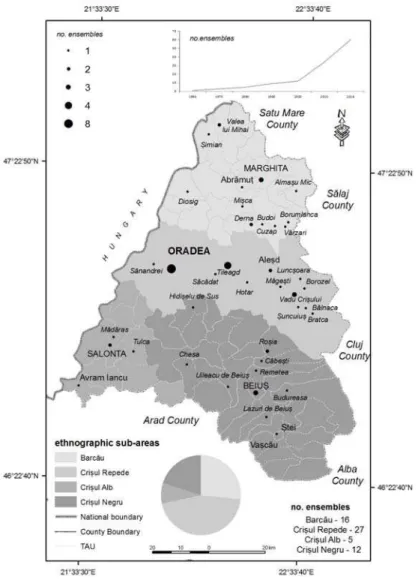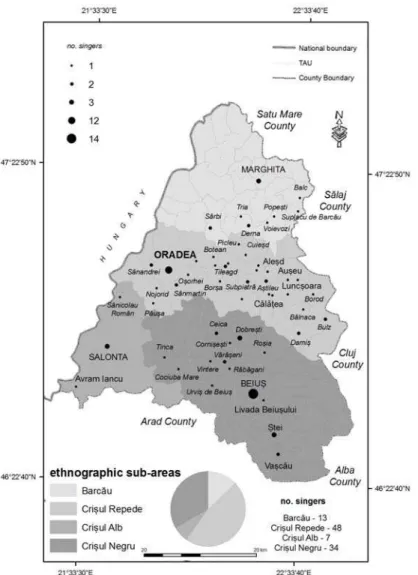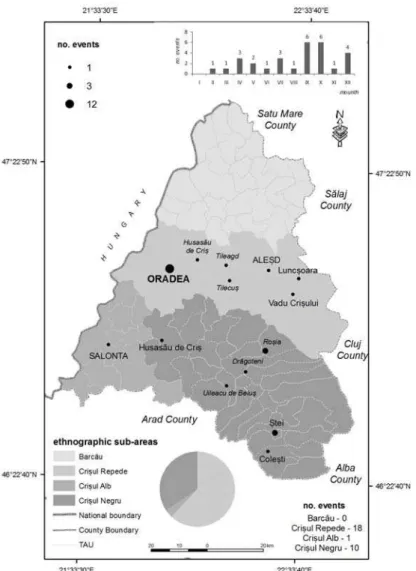ISSN 11222211--11227733, E-ISSN 22006655--33440099 Article no. 226622111166--772288
http://istgeorelint.uoradea.ro/Reviste/Anale/anale.htm
IDENTIFICATION, QUANTIFICATION AND ANALYSIS OF THE
ETHNOGRAPHIC POTENTIAL OF FOLK SONGS SPECIFIC TO
BIHOR, ROMANIA
Grigore Vasile HERMAN
University of Oradea, Department of Geography, Tourism and Territorial Planning, 1 University St., 410087 Oradea, Romania, e-mail: grigoreherman@yahoo.com
Violeta GHERMAN
Centrul Județean pentru Conservarea i Promovarea Culturii Tradiționale Bihor, Romania, e-mail: violetagherman3@gmail.com
Abstract: The present study aims to identify, quantify and analyse the tourism potential offered by folk songs specific to Bihor, or by the triad folk music - folk ensemble - specific event. This approach is necessary in the context of the evolution and rise of tourism in the last period, together with the needs and expectations of tourists to spend their time in a more pleasant and also active way, integrated in the life of host communities.
Key words: ethnographic potential, folk songs, ensembles,
* * * * * *
INTRODUCTION
Bihor County, located in the north-west of Romania, due to the physical, geographical and historical framework in which it has evolved over time, is the beneficiary of greatly valuable ethnographic tourism resources (Sta ac and Herman, 2010; Ilie et al., 2009, 2010, 2014, 2015). Among them a special place is held by the folk song and dance. Cultivated and promoted in a scientific way, the folk songs and dances can become the main tourist resources in creating the tourism identity, along with natural and anthropogenic elements (Connell and Gibson, 2003; Herman and Wendt 2011; Herman, 2012; Ilie et al., 2015, 2016; Palmer, 1999; Ury, 2001; Harvey, 1989; Mitchell, 2000; Tătar and Herman, 2013; Thrift, 2000).
Since ancient times until now, one of the most elementary and used forms of expression by man was and is the "song". It accompanies man throughout his entire existence, from birth (incantations), childhood (lullaby songs), maturity (songs of longing) and old age (songs of mourning), to death (wailing). Basically, "every nook and cranny of modern life" when "practically every human activity in Western countries either relies on or has certain commodities associated with it, from births to weddings to funerals, at work or in the home, in peace or in war" (Thrift, 2000, p. 96).
In this context, it is no wonder that the developing tourism has turned its attention in this direction due to the multiple valences and functions that songs, along with folk dances and other ethnographic features, incorporate.
The folk songs and dances can help develop and promote local and regional tourism by converting them into an easily marketable tourism product, given that currently more and more "local customs, rituals, festivals and ethnic arts become tourist attractions, performed for tourist consumption and produced for market-based instrumental activities" (Gotham, 2002, p. 1737) and develop the image of tourist destination providing "a new source of images and sounds for tourism promotion" (Gibson and Connell, 2005, p. 14).
An important contribution to this is the fact that music is a portal of knowledge of places, people, past, identity, membership etc. However, the opinions expressed by certain specialists are divided, some believe that tourism is "a homogenizing influence and its effects everywhere seem to be the same - the destruction of the local and regional landscape that very often initiated the tourism, and its replacement by conventional tourist architecture and synthetic landscapes and pseudo-places" (Relph,1976, p. 93), an element through which culture is "being destroyed in order to yield entertainment" for a consumer society (Arendt, 1993, p. 207), while others have identified positive features concerning the role and the importance of tourism in the local development and in the shaping of the tourism identity (Connell and Gibson, 2003; Herman and Wendt, 2011; Herman, 2012; Palmer, 1999; Ury, 2001; Harvey, 1989; Mitchell, 2000; Thrift, 2000).
Currently the institution dealing with the preservation and promotion of folk song and dance in Bihor County, Romania is "Bihor County Center for the Preservation and Promotion of Traditional Culture". It is "a specialized scientific and methodological institution, with the objective of knowledge through research, preservation through conservation and development, through specific ways of promoting, of the tradition and creative cultural artistic heritage and traditional art of Bihor county. It operates under the authority of Bihor County Council and is part of the main county institutions, in accordance with the Romanian legislation and the framework of its own Rules of organization and functioning". 1 In order to achieve its primary objective, the "Bihor County Center for the Preservation and Promotion of Traditional Culture" cooperates with a number of partners among which are the Cultural Center of Harghita, the Cluj County Center for Preservation and Promotion of Traditional Culture, the Cultural Center Dragan Muntean from Deva, the Timis County Center of Culture and Arts, the Covasna Centre of Culture, the Augustin Bena Center of Culture from Alba, the Liviu Rebreanu Center of Culture from Aiud, the Bucharest Center of Creation, Art and Tradition, the Gorj County Center for Conservation and Promotion of Traditional Culture, the Satu Mare Center County Conservation and Promotion of Traditional Culture, the National Center for Preservation and Promotion of Traditional Culture. 2
METHODOLOGY
From a methodological point of view this study is structured into three major research centre lines, namely: folk ensembles, folk music bards and organized events with specific character. The information needed to carry out the analysis of the previously mentioned lines aimed at both the quantitative and qualitative aspects. It was obtained from literature and field research. The analyses were performed spatially (reference units being considered: ethnographic sub-areas and locality) and temporally, in the case of the folk ensembles and organized events. The software used for their analysis was ArcGIS 9.3.
FOLK MUSIC SINGERS
They are image vectors, responsible for disseminating and fostering the folk songs in specific events attended by folk ensembles. After the bibliographic and field research, we identified in Bihor 102 folk music singers belonging to 4 sub ethnographic areas: Barcău (13 singers) Cri ul Repede (48 singers), Cri ul Negru (12 singers) and Cri ul Alb (5 singers). 3
1 http://www.culturabihor.ro/
The name of the ethnographic sub-areas derives from the name of the main hydrographical arteries that drain Bihor County from east to west (according to the general inclination of the territory), namely: Barcău, Cri ul Repede, Cri ul Alb i Cri ul Negru. Over time, these rivers were true axis of concentration for human communities or their cultural, social, political etc. manifestations. The analysis of the singers in terms of place of origin revealed their membership to 56 rural and urban localities grouped in five categories: localities with 1 singer (39 localities); localities with 2 singers (12 localities); localities with 3 singers (Marghita, Salonta, tei and Dobre ti); localities with 12 singers (Oradea) and localities with 14 singers (Beiuş) (figure 1).
Figure 1. Folk music singers in Bihor
FOLK ENSEMBLES
Figure 2. Folkloric ensembles in Bihor
At the opposite pole we have the "Junii Bihorului" Ensemble from Oradea (8 people), the "Doina teiului" Ensemble from tei (10 people), the "Fii satului" Ensemble from Alma ul Mic (10 people) and the "Cri ul" Ensemble from Oradea (10 people). The first ensemble of those currently still active in Bihor county was the folklore ensemble "Brătcuța" from the Cri ului Repede valley, founded in 1960, in the town of Bratca. From 1960 to 1990 the growth rate of the number of folk ensembles was relatively low compared with the time interval between 2000-2016, when it was more rapid, especially after 2010 (figure 2).
ORGANIZED EVENTS WITH SPECIFIC CHARACTER
They represent the territorial and temporal context for the manifestation of the folk ensembles, folk dancers and singers. In 2016, in Bihor County, Romania, 29 events were organized, during which folk ensembles performed, represented by folk singers. The monthly distribution of the events organized in 2016 in Bihor reveals an unequal distribution, the months with the highest number of events being September and October (with 6 events), followed by December (4 events). In January there were no events (figure 3).
CONCLUSIONS
After analysing the ethnographic potential of the folk music from Bihor, we reached the following conclusions: in 2016, in Bihor county were organized 29 events with specific character, to which were invited 60 folk music ensembles, within which evolved a part of the 102 singers of folk music; in the case of the ethnographic sub-areas, the situation was as follows: Barcău (13 singers, 16 ensembles, 0 events) Cri ul Repede (48 singers, 27 ensembles, 16 events) Cri ul Negru (12 singers, 12 ensembles, 8 events) and Cri ul Alb ( 5 singers, 5 ensembles, 1 event); the distribution of singers, ensembles and events highlighted the importance of the urban centres like Oradea (12 singers, 8 ensembles and 12 events), Beiuş (14 singers, 3 ensembles), Marghita (3 singers, 3 ensembles), Salonta (3 singers, 2 ensembles) and tei (2 singers, 1 ensemble). The results obtained from the present study may be an opportunity in terms of tourism development through these impressive ethnographic tourism resources. In order to achieve this desideratum, several recommendations need to be made, including: increase the number of events, keep the events calendar relatively constant from year to year, thus transforming them in traditional events, initiate various actions to promote the events both locally and regionally etc. In what concerns the development through tourism of the folk music and dance specific to Bihor, currently there are no specialized studies that could highlight the connection between the number of tourists and the ethnographic tourism potential of the folk music and dance specific to Bihor.
REFERENCES
Arendt H. (1993), Between Past and Future: Eight Exercises in Political Thought, Penguin, New York.
Connell J., Gibson C. (2003), Sound Tracks Popular music, identity and place, Routlege Taylor Franxcis Group, London and New York.
Dincă I., Herman G.V., Sztankovics G. (2012), Descoperire prin ecoturism si prin turism rural în Comuna Cetariu, Editura Universităţii din Oradea, ISBN 978-606-10-0724-0, Oradea.
Gibson C., Connell, J. (2005), Music and Tourism: On the Road again, Channel, Clevedon.
Gotham K.F. (2002), Marketing Mardi Gras: commodification, spectacle and the political economy of tourism in New Orleans, Urban Studies 39, 1735–1756.
Harvey D. (1989), The Condition of Postmodernity: An Enquiry into the Origins of Cultural Change, Blackwell, Oxford, England.
Herman G. V. (2012), The Role and the Importance of Historical Monuments in the Diversification of Touristic Services in Oaş Land, Forum Geografic, Studii i cercetări de geografie i protecția mediului Volume XI, Issue 2 December 2012, pp. 229-234 (6).
Herman G.V., Wendt J. (2011), Development and promotion of tourism, an extra chance in maintaining and asserting the identity and specificity of Oas Land, în GeoJournal of Tourism and Geosites ISSN 2065-0817, E-ISSN 2065-1198 Year IV, no. 1, vol. 7, May 2011, pag. 87-94, Article No: 07108-72.
Ilieş A. (coord.), Baias Ş., Baias Iuliana, Blaga L., Buhaş S., Chiriac A., Ciocan J., Dăncuş M., Deac Anca, Dragoş P., Dumitrescu Ghe., Gaceu O., Godea I., Gozner Maria, Grama V., Herman G., Hodor N., Hurley P., Ilieş A., Ilieş Dorina, Ilieş Gabriela, Ilieş M., Josan Ioana, Leşe G., Măduţa F., Mojolic Diana, Morar C., Olaru M., Staşac M., Stupariu M., Sturza Amalia, Ştefănescu B., Tătar Corina, Vârnav R., Vlaicu M., Wendt J. (2014), Crişana - Maramureş, Atlas Geografic al patrimoniului turistic, Editura Universităţii din Oradea, ISBN 978-606-10-12-96-5, Oradea.
Ilieş A., Ilieş D. C., Josan I., Grama V., Herman G.V, Gozner M., Stupariu M., Gaceu O., Staşac M. (2009), Cosău Valley (Maramureş), Evaluation of Antropic Patrimony (I), în Geojournal of Tourism and Geosites, Year II, no.2, vol. 4, Oradea-Gdansk.
Ilieş A., Ilieş D. C., Josan I., Wendt J., Herman G. V., Grama V. (2010), The identification, evaluation, quantification and capitalization through tourism of the authentic resources from Crisana-Maramures with the purpose of elaborating a strategy of cross-border integrated sustainable development. Methodological approach, in Analele Universitatii din Oradea, Seria Geografie, Tom XX, no. 1/2010 (June), pp. 127-140, Oradea.
Ilie A., Wendt J. A., Ilie D. C., Herman G. V., Ilie M., Deac A. L. (2016), The patrimony of wooden churches, built between 1531 and 2015, in the Land of Maramure , Romania, Journals of Maps 12(Supp1), 597-602.
Ilie Dorina Camelia, Buha Raluca, Ilie Alexandru, Morar Cezar, Herman Grigore Vasile (2015), Nymphaea Lotus Var. Thermalis (Pârâul Peţea Nature Reserve), Brand Near Extinction of the Băile Felix - Băile 1 Mai (Romania) Spa Tourism System, GeoJournal of Tourism and Geosites Year VIII, no. 1, vol. 15, May 2015, p.107-117, ISSN 2065-0817, E-ISSN 2065-1198 Article no. 15109-190.
Palmer C. (1999), Tourism and the symbols of identity, Tourism Management 20 (1999), pp 313 - 321. Relph E.C. (1976), Place and Placelessness, Pion, London.
Staşac M., Herman G. V. (2010), Ethnographic values in the traditional village of Zarand Land, in GeoJournal of Tourism and Geosites, Year III, no. 2, vol. 6, November 2010, pag. 140-150.
Tătar C. F., Herman G.V. (2013), Identity Encounters. Host-Guest Interractions in the Land of Moţi, GeoJournal of Tourism and Geosites, Year VI no.1, vol. 11, June 2013, pp. 66-74, Oradea.
Thrift N. (2000), Commodity. In: Johnston, R.J., Gregory, D., Pratt, G., Watts, M. (Eds.), The Dictionary of Human Geography, Blackwell, Malden, pp. 95–96.
Urry J. (2001), The Tourist Gaze: The New Edition, London, Sage.
http://www.culturabihor.ro/ [Accessed 20 December 2016]
http://www.culturabihor.ro/index.php?s=8&lang=ro&id_page=2 [Accessed 20 December 2016]
http://www.culturabihor.ro/index.php?s=11&lang=ro [Accessed 20 December 2016]


